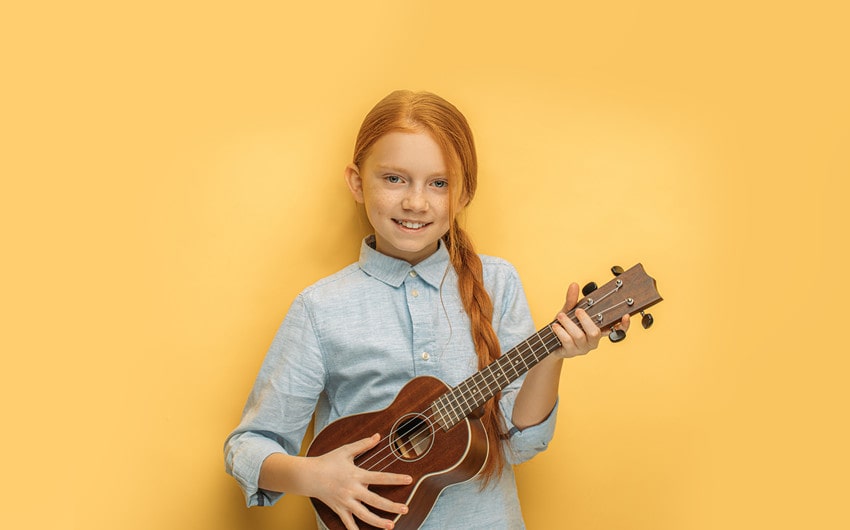20 Easy Ukulele Songs for Kids That Make Learning Fun and Fast
If you’re looking for easy ukulele songs for kids, you’re already on the right track to making music fun and approachable. The ukulele is one of the best instruments for children to start with—small enough for tiny hands, simple enough for quick progress, and cheerful enough to keep things light. Whether you’re teaching your child at home, helping students in a classroom, or just introducing music in a playful way, the right songs can make learning feel like magic. Here are 20 kid-friendly tunes that are simple to play, easy to sing, and full of joy.
1–2 Chord Songs (Absolute Beginners)
These songs use just one or two chords, making them perfect for early learners. They help build strumming patterns, rhythm, and confidence without overwhelming beginners.
1. Row, Row, Row Your Boat
This timeless children’s song is one of the best places to start for absolute beginners. It typically uses a single chord—C major—making it ideal for learning to hold a chord and strum steadily. It’s also a fantastic introduction to playing in a round, helping children build rhythm and listening skills while singing. Because the lyrics are repetitive and the melody is simple, kids can focus more on playing than memorizing. It’s great for solo practice or group fun, especially if you want to get multiple kids involved in a musical activity.
2. Are You Sleeping (Frère Jacques)
A gentle song with a soft melody, “Are You Sleeping” uses just two chords—C and G7. This is a great next step after mastering single-chord songs. The progression is slow and predictable, so kids can take their time with chord transitions. Plus, the call-and-response format is fun for playing with others. Because the melody is the same as “Brother John” in English and many other languages, it’s also a great cross-cultural teaching tool. Use this song to reinforce timing, repetition, and beginning melody playing.
3. Rain, Rain, Go Away
This nursery rhyme is short, sweet, and easy to play with one or two chords—commonly C and G7. The song is great for reinforcing basic strumming and chord changes. Because the lyrics are simple and relatable (especially for kids who’ve ever wanted to play outside in the rain), it captures attention quickly. Use this one to practice tempo and to begin experimenting with dynamics (playing louder or softer). For added fun, let kids act out parts or sing it with their own twist—like inserting names or new weather events.
4. One, Two, Buckle My Shoe
This song introduces basic counting in a fun and rhyming way, often played with just the C chord throughout. You can optionally add G7 to increase variety once kids are comfortable. The tempo is easy to control, making it ideal for slowing things down to match each learner’s pace. Because the song counts up in rhymes (e.g., “Three, four, shut the door”), it pairs naturally with finger-tapping or clapping, which adds a multi-sensory component to learning. Perfect for building confidence while reinforcing counting and strumming coordination.
5. The Farmer in the Dell
This traditional folk song is catchy and circular, often played with a single chord—C major. It’s excellent for classroom or group settings because each verse allows kids to act out characters like “the farmer,” “the wife,” or “the cheese.” Even if just strumming one chord, kids stay engaged through interaction and repetition. If you want to introduce variation, you can add G7 for a simple two-chord version. The predictable structure gives kids a reliable framework to focus on strumming and vocal timing without getting overwhelmed.
3–4 Chord Songs (Next Step Up)
Once kids are comfortable with basic transitions, these songs introduce a little more complexity while still keeping things very approachable.
6. Twinkle, Twinkle, Little Star
This universally loved children’s song is great for beginners ready to tackle three chords: C, F, and G. It follows a simple I–IV–V chord structure, which is foundational in many songs. The melody is smooth and easy to sing, giving kids confidence as they begin to manage chord transitions. Because it shares a tune with “Baa Baa Black Sheep” and the “Alphabet Song,” it’s also useful for practicing the same chords across different lyrics. You can use this to teach the concept of musical phrasing and how songs can have multiple verses with the same structure.
7. You Are My Sunshine
A warm, feel-good tune, “You Are My Sunshine” helps kids practice C, G, F, and Am (A minor). Though it introduces a fourth chord, the changes are manageable and repetitive. This song teaches chord timing and mood—it’s cheerful in tone, but can also be slowed down to sound tender. Its familiar lyrics and singable melody make it a favorite in classrooms, at home, or around the campfire. For young learners, it’s a great way to explore both upbeat and soft strumming techniques while staying engaged with emotionally resonant lyrics.
8. Mary Had a Little Lamb
This gentle melody is great for learning C, F, and G7 chords. The song’s slow tempo gives kids time to place their fingers properly, and the repetitive melody helps reinforce chord memory. It also introduces the idea of playing chord changes that line up with syllables in a sentence—something that’s key to good musical timing. For more advanced learners, you can also teach them to pick out the melody on a single string, making this a flexible tune that grows with the child’s skills.
9. London Bridge Is Falling Down
Using a standard set of C, G7, and F chords, this traditional song introduces a lilting rhythm that helps kids develop smoother transitions and consistent tempo. It’s ideal for teaching call-and-response or split-group performance (one side sings the “London Bridge” part, the other replies). The repeating structure of the lyrics also allows kids to predict what comes next, helping them stay in rhythm. This song works well in a classroom or duet setting, and it’s also a fun option to experiment with using light percussive strumming or simple claps.
10. This Land Is Your Land
This folk classic by Woody Guthrie may feel more grown-up, but its simple chord structure—C, G, F, and D7 (optional)—makes it accessible for kids too. The lyrics promote unity, geography, and inclusivity, making it a great pick for school programs or family singalongs. It’s a solid next step for learners who are ready to add emotional and lyrical meaning to their music. Strumming can be kept basic (down-down-up-up-down-up works well), and the rhythm is forgiving enough for beginners to stay on track. This song is also great for developing stronger vocal projection.
Action Songs and Sing-Alongs
These songs get kids moving or participating vocally in a fun way. Great for classrooms, group learning, or high-energy practice sessions.
11. If You’re Happy and You Know It
This classic call-and-response song is full of energy and fun—and perfect for active learning. Typically played with C, G7, and F, the song helps kids link chord changes with actions like clapping hands, stomping feet, or shouting “hooray!” The repeated pattern makes it easy to follow, and the interactive format helps maintain focus and enthusiasm. It’s a great way to teach kids to anticipate chord changes based on musical phrasing. For classroom use, each verse can highlight a different action, keeping everyone moving, laughing, and learning as they strum.
12. The Wheels on the Bus
With C, F, and G7 chords, this widely loved children’s tune is a great way to introduce storytelling through music. Each verse describes a part of the bus and its sound or motion, giving kids a chance to act out lyrics while playing. It’s repetitive, which helps solidify chord changes, and the melody is simple and steady. Teachers and parents can use this song to introduce musical dynamics—playing verses louder or softer based on the action—and encourage expressive strumming. It’s perfect for groups, with built-in movement and lots of room for creativity.
13. Old MacDonald Had a Farm
A cheerful song that builds vocabulary and musical anticipation, “Old MacDonald” usually uses C, G7, and F. Its charm lies in the animal sounds, which kids love to mimic, making the experience engaging and silly. Every verse follows the same pattern, helping reinforce chord timing and structure. You can let kids choose which animals to add, which keeps things playful and fresh. This song is great for developing memory, vocal projection, and coordination between chord changes and lyrical rhythm—all in a lively, interactive format.
14. Head, Shoulders, Knees, and Toes
This movement-based favorite uses C and G7 and adds a physical component to musical learning. As children sing and point to their body parts in rhythm, they’re also reinforcing tempo and muscle memory. Since the tempo usually increases with each repetition, it’s an excellent tool for developing strumming speed and accuracy. Despite the simple chords, the challenge lies in syncing motions with music. It’s ideal for group settings where you want to blend exercise, music, and memorization in a fun, fast-paced format.
15. Hokey Pokey
Silly and social, “The Hokey Pokey” is perfect for group learning and musical fun. Usually played with C, F, and G chords, the song’s clear pattern and spoken-style singing help ease the pressure of staying perfectly in tune. Each verse involves putting a different body part in, shaking it, and turning around—great for physical engagement and learning to keep rhythm while moving. This tune helps reinforce chord repetition and pacing, and it encourages confidence through laughter. Plus, it’s a fun icebreaker or warm-up song for beginner ukulele players.
Nursery Rhymes and Lullabies
These songs have gentle melodies, slow tempos, and are ideal for quiet time or bedtime practice. They help kids focus on tone and chord clarity.
16. Baa Baa Black Sheep
A simple, calming song perfect for winding down, “Baa Baa Black Sheep” shares its melody with “Twinkle, Twinkle, Little Star” and uses the same basic chords: C, F, and G. This makes it especially useful for reinforcing previous learning in a fresh way. Its lullaby-like tempo allows children to focus on strumming consistency and chord clarity without feeling rushed. Because it’s so familiar, even shy singers usually feel comfortable joining in. Great for bedtime routines, music circles, or any time you want to create a peaceful atmosphere while reinforcing beginner ukulele skills.
17. Hush Little Baby
This gentle lullaby follows a repetitive and flexible melody that you can adapt to many chord progressions—often using C, G7, and F, or even just C and G7 for simplified versions. Its soft tempo and soothing tone are great for teaching emotional nuance in music. The song’s cascading rhymes (“Papa’s gonna buy you a mockingbird…”) help kids predict what’s coming, and that familiarity boosts confidence. It’s also a fantastic piece for working on fingerpicking basics, which makes it versatile for kids who are ready to try something beyond strumming.
18. Rock-a-Bye Baby
“Rock-a-Bye Baby” is a traditional lullaby that can be played with C, F, and G7 chords. The melody is sweet and flowing, perfect for teaching how music can express tenderness and calm. Though the lyrics are a bit somber, kids are often captivated by the dreamy rhythm. It’s ideal for slower strumming practice and breath control in singing. For a twist, try using soft palm-muted strums to mimic a rocking motion, which introduces dynamic control while reinforcing the lullaby mood. This is an excellent choice for quiet practice or ending a lesson on a gentle note.
19. Brahms’ Lullaby (Lullaby and Goodnight)
This beautiful, classical lullaby may introduce a slight challenge for young learners, but it’s still accessible with C, G, Am, and F chords. Its soothing progression and romantic melody are ideal for developing a sensitive playing style. It’s also a fantastic song to use when teaching kids about music from different cultures and time periods. Slowing down the strumming or breaking the chords into arpeggios (picking one string at a time) adds variety and teaches dexterity. Brahms’ Lullaby works wonderfully in performances, making it both educational and emotionally resonant.
20. All the Pretty Little Horses
This hauntingly beautiful lullaby introduces kids to minor keys, often using Am, C, and G. The melody is soft and melodic, with lyrics that carry both comfort and mystery. It’s a fantastic song for more emotionally intuitive play and helps kids understand that music doesn’t always have to sound happy to be beautiful. You can use fingerpicking patterns to bring out the lullaby’s gentle flow or keep it simple with slow down-strums. This piece adds variety to a repertoire and encourages expressiveness and storytelling through song.






